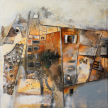Zhuravel, Mykola
Mykola Zhuravel breaks the boundaries between painting and sculpture, performance and installation art. Zhuravel turns to nature to create thriving monuments to man’s links to the Earth itself. He searches for compatibility between Earth and mankind, while pointedly making reference to the obstacles that human beings have placed in the way of a harmonious existence. Zhuravel’s ambitious style results in a remarkable series of living images of a visionary utopia, ranging from his beehive sculptures to his thought provoking installations of glass jars that become virtually transcendental. Born into a family of beekeepers, Zhuravel incorporates elements and products of beekeeping with traditional media into his work. Zhuravel uses honey, beeswax, and the actual beehive itself, along with other unusual media, such as tea and wine to create his unique works of art. The exquisite conceptual works present an arresting and deeply affecting array of images based on the age-old practice of nurturing honeybees. Equally striking are Zhuravel’s paintings. By using levkas, a traditional primer employed by icon painters, Zhuravel unites the legacies of Byzantine and Rus icon painting with his contemporary painterly technique. The result, richly vibrant and inventive contemporary works that emerge as modern-day icons.
Zhuravel was born in 1960 in Ukraine and graduated from the prestigious Kyiv State Arts Institute (now the National Academy of Visual Arts and Architecture of Ukraine) in 1989. He has exhibited widely in Ukraine, Russia, Switzerland, Japan, and the United States. An active participant in the events of Ukraine’s democratic Orange Revolution of 2004, he currently resides in Kyiv, Ukraine. His works are held in prominent private and museum collections in Ukraine and the United States.
*No part of this text may be reprinted, stored in a retrieval system, or transmitted, in any form, by any means, electronic, mechanical, photocopying, recording, or otherwise, without prior permission from the gallery.
Mykola Zhuravel's challenging work exists simultaneously on several levels, all extraordinary for their range of expression and unusual originality. His remarkably varied modes include sculptural interpretations of working beehives, richly textured sentinels with clearly atavistic fins and crests, and there are also contrary, mixed-media expressions that subtly relate to his archetypal, yet also sophisticated modern forms. These varied expressions have an engaging, immediate appeal, with their pierced, patched and otherwise lush, organic surfaces treatments and varied contours. Raised grids articulate the complex structure of "Solar Battery No. 2," with its rusty, honeyed tones, and the warm colors and and the gentle rhythms of "Bee Paradise which engage the observer's eye as surely as pink and orange petals actually attract bees.
Beneath the enigmatic, stirring primal forms and patterns of his two- and three-dimensional forms, however, the distinguished, experimental Ukrainian master engages a deeply felt set of principles and meanings. His work is clearly functional and linked to a moving, age-old culture of raising bees! He has discerned in this daring expressive metaphor his need and desire to acknowledge significant links between man and nature. On another expressive level, his striking imagery of fire and destruction aludes to his imbedded resistance to repression in the former Soviet Union. It was only with the decline of Stalin's reign that Zhuravel finally felt free to express himself confidently, without political or artisitc inhibition. In his brilliantly cohesive, original and daring visual statements Zhuravel has ranged from conceptual art to major, modernist sculpture forms, and his fresh and original expression presents a cohesive, wonderfully provocative world view. At the same time, he continues to expand his remarkable range of expression, as he both challenges and engages the concerned viewer's eye and intellect in a daring and wholly original manner.
Dr. Sam Hunter, Emeritus Professor of Art History, Princeton University















































